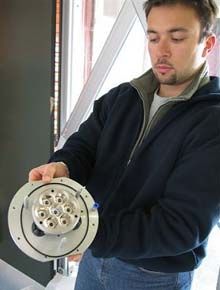Successful testing of Jules Verne videometer

The videometer’s eye-like sensors will enable incredible precision <br>Credits: Frederic Castel
For the first time, the ’videometer’ (VDM), a new technology device to ensure very precise automatic rendezvous operations between the 20.7 tonne Jules Verne Automated Transfer Vehicle and the ISS, has been successfully tested this month.
State of the art
Based on the design of a star tracker, the Jules Verne videometer, which is the first automatic optical operational system ever used for spacecraft navigation, has been through extensive simulated rendezvous tests. This state of the art rendezvous technology is the crucial part of the new European cargo spaceship to which it gives its specific name of Automated Transfer Vehicle (ATV).
„For the first time, the ATV rendezvous sensors were used successfully in real conditions. And, within their operational domain, they worked exceptionally well,“ said ESA ATV engineer Stein E. Strandmoe, who supervised a critical 10-day test campaign.
Precision
For the final rendezvous manoeuvres, the ATV will use its videometer eye-like sensors, combined with additional parallel measurement systems, which allow an automatic docking with an incredible centimetre precision while the spacecraft and the ISS are circling the Earth at 28 000 km/h. „The first European rendezvous spacecraft is expected to dock with ISS next year with the accuracy of the size of a one Euro coin“, said ESA astronaut Jean-François Clervoy, senior advisor to the ATV programme.
These built-in automatic capabilities of the ATV must be compatible with the demanding requirements of human spaceflight safety, necessary for the permanently crewed ISS.
Target patterns
The videometer is able to analyse images of its emitted laser beam automatically reflected by passive retroreflectors serving as targets installed on the Station, next to the Russian docking port where the ATV will be attached.
During the last 200 metres of the orbital final approach manoeuvre, the videometer must automatically recognize the retroreflectors target patterns and then calculate the distance and direction to the docking port.
This precise tracking of the relative motion between the two spacecraft as they get closer – starting at a speed of up to 3.6 km/h – provides indispensable information to the on-board Guidance, Navigation and Control (GNC) system, which automatically pilots the bus-sized cylindrical ESA cargo ship towards the ISS.
Rendezvous testing
To realistically check the videometer capabilities – in targeting and acquisition – the tests were conducted in a hi-tech ship hull research facility at the French defence agency ’Délégation Générale pour l’Armement’ (DGA), located in Val-de-Reuil, 100 km west of Paris. A contract between ESA and DGA will allow further ATV rendezvous testing, including during the Jules Verne flight, if needed.
Inside an exceptional building, 600 metres in length, a 120 000 kg mobile platform, able to ride on 550 metre long rails, enabled the simulation of a continuous approach between the two space vehicles from a range of several hundred metres to within almost docking distance. On the platform, a set of passive rendezvous targets (retroreflectors), identical to the ones to be installed on ISS, were facing the videometer which was mounted on an articulated robotic arm (with six degrees of freedom) representing the ATV motion.
This seven metre high mobile arm was used to simulate the angular movements of the ATV to check if the videometer was still able to target the ISS retroreflectors and provide the information to the ATV control system necessary to adjust its trajectory accordingly.
First time success
The results of the test campaign showed that the whole videometer system – that is to say the laser illuminator and the image analyser of the reflected laser beams – was able to continuously track the simulated ISS platform from a distance of 313 metres, right up close to docking. „We have stable acquisition and tracking in its entire operating domain,“ said Stein Strandmoe. At greater distances, Jules Verne will use a relative GPS reference system to get closer to the Station.
„The most surprising thing was that the sensors were almost undisturbed when we tried to fool them with other reflecting surfaces or other lights that could interfere with rendezvous targets in the ISS background,“ said Strandmoe. „It’s amazing how the videometer, as a totally new development, proved to be such a robust system. I was quite surprised that it worked so well the first time it was tested!“
Media Contact
Weitere Informationen:
http://www.esa.int/esaHS/SEMXIUYV1SD_index_0.htmlAlle Nachrichten aus der Kategorie: Verfahrenstechnologie
Dieses Fachgebiet umfasst wissenschaftliche Verfahren zur Änderung von Stoffeigenschaften (Zerkleinern, Kühlen, etc.), Stoffzusammensetzungen (Filtration, Destillation, etc.) und Stoffarten (Oxidation, Hydrierung, etc.).
Unter anderem finden Sie Wissenswertes aus den Teilbereichen: Trenntechnologie, Lasertechnologie, Messtechnik, Robotertechnik, Prüftechnik, Beschichtungsverfahren und Analyseverfahren.
Neueste Beiträge

Wirkstoff-Forschung: Die Struktur von Nano-Genfähren entschlüsseln
LMU-Forschende haben untersucht, wie sich kationische Polymere beim Transport von RNA-Medikamenten auf molekularer Ebene organisieren. Kationische Polymere sind ein vielversprechendes Werkzeug für den Transport von RNA-Therapeutika oder RNA-Impfstoffen und werden…

Entwicklung klimaneutraler Baustoffe
…aus biogenen Materialien unter Einsatz phototropher Mikroorganismen. Das Fraunhofer-Institut FEP in Dresden bietet skalierbare Forschungs- und Entwicklungsmöglichkeiten, um technologische Innovationen auf neue Produktionsprozesse anzuwenden. Angesichts der steigenden Nachfrage nach klimaneutralen…

Optimiertes Notfallmanagement dank App
Wie die eGENA-App bei Notfällen in der Anästhesie hilft. Mit der eGENA-App hat die Deutsche Gesellschaft für Anästhesiologie und Intensivmedizin e.V. (DGAI) ein digitales Werkzeug geschaffen, das den Klinikalltag bei…



